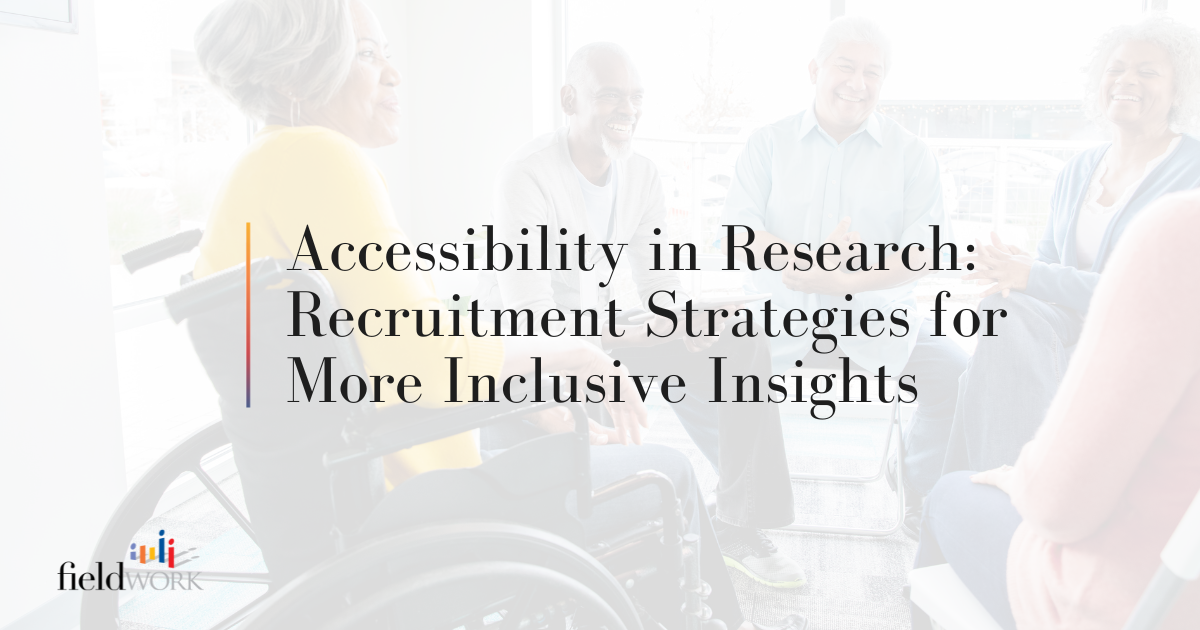In research, inclusivity isn’t just a buzzword but a principle that defines the credibility and impact of any study. As researchers strive to gain insights into diverse perspectives, the question arises: How can we ensure that our participant recruitment processes, and research venues are accessible to all?
When attempting to recruit individuals with various accessibility requirements, researchers must ask challenging questions to ensure all parts of their study are accessible. Adaptable communication, inclusive recruiting strategies, and accessible research venues are just some the complexities that need to be addressed to make research truly inclusive – reaching participants right where they are.
Limitations of DIY
Research methodologies often grapple with the dilemma of DIY (Do It Yourself) approaches versus relying on professional partners, particularly when it comes to participant recruitment. While tapping into friends and family may seem convenient, it presents inherent challenges in ensuring a diverse and representative sample. The potential for bias and limited perspectives calls for a critical examination of recruitment channels, urging researchers to broaden their horizons and explore vendor partnerships that can offer a more diverse participant pool.
Connection is Key for Inclusive Recruiting
Adaptable communication is at the heart of inclusive recruiting. Embracing human-to-human conversations fosters a sense of connection and understanding between researchers and participants. Creating opportunities for participants to ask questions not only empowers them but also ensures that the research process is transparent and approachable. Recognizing the diverse communication preferences of potential participants is vital; researchers should offer alternatives beyond verbal communication to accommodate a wide range of needs, whether they be written, visual, or other forms of expression.
Ensuring Accessible Research Venues
 Physical Space Considerations
Physical Space Considerations
These are pivotal in creating an inclusive research environment. Wheelchair accessibility is a fundamental aspect that cannot be overlooked, ensuring that the research venue is welcoming to participants with limited mobility.
Attention to details like door size and bathroom facilities is essential for creating an environment that caters to the diverse needs of participants. Parking accessibility, often underestimated, plays a significant role in ensuring that participants can easily access the research venue, removing potential barriers that may deter participation.
Customizing Check-In Processes
This involves a human touch. Personalizing interactions during check-in can go a long way in making participants feel seen and valued. Conducting respondent-specific needs assessments allows researchers to tailor the research experience, considering individual requirements and preferences.
Varying Methodologies for Inclusivity
Employing online research platforms or offering in-home research options provides flexibility and convenience, helps accommodate participants' lifestyles and preferences.
Strategies for Ensuring Inclusive Recruitment or Venue Partners
Utilization of Robust Opt-In Database
Database representation is crucial, ensuring that participant databases reflect the diversity of conditions relevant to the study, such as diabetes, multiple sclerosis, or arthritis. By maximizing the potential of comprehensive databases, researchers can tap into a broad spectrum of potential participants. However, having a database is not enough. The system being utilized needs to prioritize accessibility best practices. Every respondent’s user experience needs to be considered.
Cultivating Engagement in Alternative Communities
Meeting participants where they are involves leveraging contemporary communication channels. Social media engagement has become a powerful tool for reaching a broad and diverse audience. Utilizing hashtags and forming partnerships with influencers can amplify the reach of recruitment efforts. Additionally, supporting online communities and groups provides a platform for researchers to tap into existing networks, ensuring a more comprehensive and varied participant base.
Applied Experience Recruiting Diverse Respondents
Recruiters experienced with medical targets recognize the potential need for adjustments when connecting with individuals living with accessibility challenges. Developing successful strategies to accommodate diverse needs underscores a commitment to providing equal opportunities for all potential participants.
When recruiting individuals with low vision an experienced medical recruiter will apply accessibility best practices to every step of the process. For example, all reading materials, whether in-person or online, have the appropriate contrast and alt text is applied.
Consider Working with a Partner
Ensuring accessibility and inclusivity in research recruitment can be challenging. Consider working with a research support service partner experienced in recruitment, respondent management, communication, and day-of logistics. This allows researchers to stay focused on the research at hand.
Accessibility is Foundational
Researchers understand the valuable insights diverse perspectives offer. By adopting inclusivity as a guiding principle, researchers can implement personalized approaches in participant recruitment and research venue selection. Through emphasizing flexible communication styles, utilizing varied recruitment strategies, and guaranteeing accessibility in physical and virtual spaces, we engage participants on their terms.





